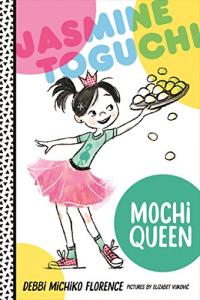
Gigi’s full name is Geraldine Hanako. Her grandfather, Ojiji, can say Gigi’s middle name easily and it is shorter than her first name – at least when it’s written in Japanese. What will Gigi decide when she wants to be rid of her “baby” name? Readers will appreciate the dilemma as they glimpse into one Japanese American family.
Gigi and Ojiji: What’s in a Name?

Gigi can’t wait for her mother’s father, her grandfather, to arrive from Japan to live with them. But Ojiisan isn’t at all what the biracial girl expected. How grandfather and granddaughter learn about the other is affirming and heartwarming in this easier to read tale.
Gigi and Ojiji

The relationship between mischievous three-year-old Nori and her grandmother shines through these pages in rich detail, full of humor, feeling, and a sense of family history and tradition. Beautifully drawn locations in Japan and Hawaii immerse the reader in their world, populated by grinning bats, leaping rabbits, a taste of Mochi — and the wonder and curiosity of childhood. The story weaves in East Asian folklore and Japanese culture, through the legends her grandmother shares.
Nori

Readers are invited to “Come. Sit. Taste…” a female chef’s determination to succeed. Chef Niki became known for the fusion of Japanese and American foods bringing a unique flavor to America. A brief discussion of kuyashii (defeated feeling) and kaiseki (a traditional Japanese feast) plus a Wonton Pizza recipe concludes this fascinating book.
Niki Nakayama: A Chef’s Tale in 13 Bites

Nature comes alive in each classic haiku accompanied by an expressive, imaginative painting. The poems appear in both English and Japanese, which is also transliterated to facilitate pronunciation.
My First Book of Haiku Poems: A Picture, a Poem and a Dream

Jasmine is only 8 years old but wants to do what the boys do. It’s her family Japanese tradition for the boys to pound the rice for mocha at her family’s New Year’s celebration. But can she really handle it? Readers of all backgrounds will empathize with Jasmine’s dilemma and see themselves in her.
Jasmine Toguchi: Mochi Queen

This sensitively crafted picture book offers a glimpse into the life and work of Japanese poet Kaneko (1903–30). Accompanied by colorful, soft illustrations, the first half recounts Kaneko’s short life along with a selection of her poems that thematically complement the text. The second half is a larger (also illustrated) collection of her poems in English and Japanese.
Are You an Echo? The Lost Poetry of Misuzu Kaneko

When Yoshio opens his door, the sounds of Tokyo surround him. Where would he find silence? Not at home or in school or in the forest. No, Yoshio finds silence “between and underneath every sound.” Detailed illustrations show the contemporary Japanese city with the use of color punctuating the child’s discovery.
Sound of Silence

Short, evocative poems – haiku – present clues about familiar animals. With a turn of the page, the answer is revealed in bold typeface and a charming illustration. This short poetic form is effectively used to play a guessing game.
Guess Who, Haiku

The author/illustrator’s look back at his early years started in Drawing from Memory (2011) continues here. Allen doesn’t really fit in at his father’s friend’s Southern California military academy. Leaving it was the start of a journey toward finding the artist within. Told through a variety of artistic pieces and styles and a highly person narration, readers will empathize and ache with this Caldecott winning artist.
The Inker’s Shadow

A poetic, playful look at an orangutan family in the wild takes as they dance their way through the trees of the rainforest. A poetic form called the “tanka” combines with animated illustrations for a jaunty glimpse of these appealing primates.
Orangutanka

A farmer and his wife longed for a child and miraculously got one who they named Issum Boshi, the One-Inch Boy. Though small, Issum Boshi proved his bravery in this Japanese tale. Imaginative illustrations suggest art from both the East and the West bring the hero into focus.
Issun Boshi: The One-Inch Boy

The seasons of a year are presented in realistic illustrations and thoughtful, evocative haikus. A brief note about the form is followed by a final poem: “Earth circles the sun/spinning a tapestry of/days, months, seasons — life.”
The Year Comes Round: Haiku through the Seasons

The narrator recalls his first Christmas in Japan and why his mother decorated a tree with a thousand paper cranes as she relives her holidays in California. Based on a family story, Say’s illustrations evoke a holiday in two cultures.
Tree of Cranes

An elderly kamishibai man travels the route on which he once told stories using his paper theater. Though the city is now crowded and noisy, the children — now grown — remember and stop once more. A note about kamishibai and stunning illustrations create broad reader appeal.
Kamishibai Man

Traditional wooden Kokeshi dolls inspired this introduction to Japanese words and culture while presenting a participatory book with flaps to lift, fold-outs and more.
Kimonos

A cat befriends a monk and brings good fortune to his rundown temple in this handsomely illustrated retelling narrated by Tama, the feline hero.
I Am Tama, Lucky Cat: A Japanese Legend

Yoko disobeys her mother by taking her special Japanese doll to school and is heartsick when it is broken. Her mother reassures Yoko that she loves her in spite of her mistake and takes Miki to a doll hospital for repair. Textured, evocative illustrations effectively convey feelings and Yoko’s Japanese heritage.
Yoko’s Show and Tell

Lyrical text and rich collage illustrations combine to tell the story of a brown cat named Wabi Sabi as he discovers the meaning of his name. As Wabi Sabi’s journey unfolds so, too, does the reader’s understanding of Japanese culture and sensibility.
Country of origin: Japan
Wabi Sabi

Grandmother has a surprise for Mayumie — is it a visit to the zoo, a museum, or the big city? When they finally reach their destination, Mayumie understands what makes visiting a cherry blossom grove so special: the beautiful pink flowers only bloom once a year! Readers will be enchanted by the magic of the story and the illustrations that capture the stunning colors of the cherry blossom trees. An author’s note provides historical details, as well as information on the cherry blossom trees in Washington, DC.
The Falling Flowers

Say narrates the saga of his grandfather who as a young man travels to the United States in the early 20th century, marries, and returns to Japan. Watercolor portraits of people and places glimpse the contrast of cultures and parallel the lives of grandfather and grandson. It could lead to a discovery of family histories. Country of origin: Japan
Grandfather’s Journey

Sophisticated readers will appreciate the sly humor and wordplay in the “kissin’ cousin of haiku.” Senyru focuses on everyday activities (e.g., “Freedom vanishes, as the babysitter arrives… kids are tied in nots”) complemented here by comic illustrations.
Wing Nuts: Screwy Haiku

Travel with Annie and Jack to the city of Edo in 17th century Japan on a Magic Tree House Merlin mission to find one of the secrets of happiness. The siblings spend an exciting day with the wise and respected teacher, Basho, using their research skills for a fast-paced, informative, and fantastic adventure.
Dragon of the Red Dawn

This richly illustrated collection of haiku poems is a counting book as well as an introduction to Japanese gardens and to a poetic form. From one leaf chased by a little girl to 10 stone lanterns, this garden can be enjoyed on several levels.
